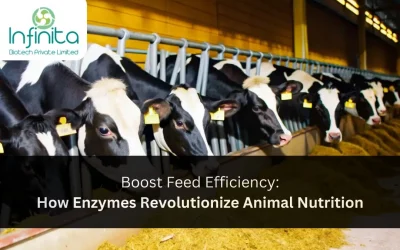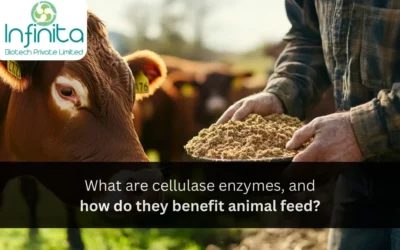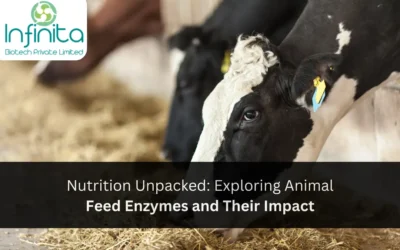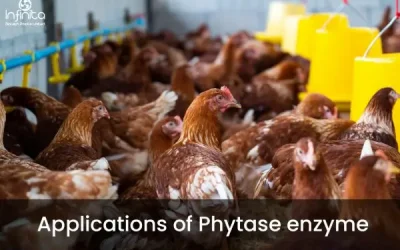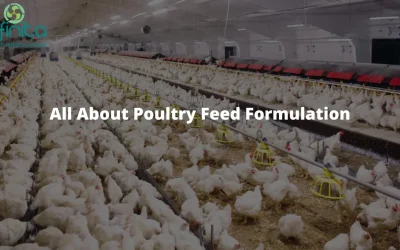Animal feed enzymes are a crucial component in livestock nutrition. They play a vital role in improving digestion and nutrient utilization, ultimately leading to enhanced animal performance and overall health. Understanding the basics of animal feed enzymes, their types, and how they work is essential for maximizing the benefits they offer.
Understanding the Basics of Animal Feed Enzymes
Definition of Animal Feed Enzymes
Animal feed enzymes are naturally occurring proteins that act as biological catalysts, facilitating the breakdown of complex nutrients into simpler forms that can be digested and absorbed by animals. They are added to animal feed to supplement endogenous enzyme production and improve nutrient availability.
These enzymes are classified into different categories based on their mode of action, including carbohydrases, proteases, and lipases. Carbohydrases target carbohydrates, breaking them down into sugars, while proteases focus on proteins, breaking them down into amino acids. Lipases, on the other hand, target fats, breaking them down into fatty acids and glycerol. Each type of enzyme plays a specific role in the digestive process, ensuring the efficient breakdown of nutrients.
The Importance of Enzymes in Animal Nutrition
Enzymes play a vital role in ensuring optimal digestion and nutrient utilization in animals. They help break down dietary components like proteins, carbohydrates, and fats, transforming them into forms that can be easily assimilated by the animal’s body. Enzyme supplementation in animal feed increases nutrient absorption, improving feed efficiency and reducing nutrient wastage.
Furthermore, enzymes enhance the utilization of feed ingredients that would otherwise be less digestible, such as plant-based proteins or fibrous materials. By unlocking the nutritional potential of these ingredients, enzymes contribute to formulating cost-effective diets without compromising animal performance.
Enzymes also aid in reducing environmental pollution by decreasing the amount of undigested nutrients excreted by animals. This not only benefits the environment by minimizing nutrient runoff into water bodies but also enhances the overall sustainability of animal production systems.
The Different Types of Animal Feed Enzymes
Protease: Breaking Down Proteins
Proteases are enzymes that break down dietary proteins into smaller peptides and amino acids. They are particularly effective in improving the digestion of plant-based proteins like soybean meal, which can contain anti-nutritional factors that hinder protein utilization in animals.
By breaking down complex proteins into readily absorbable forms, proteases enhance protein utilization, leading to improved animal growth and muscle development.
But did you know that proteases also have other benefits? These enzymes can help reduce the environmental impact of animal farming. When animals are fed with protease-enhanced feed, they produce less nitrogen waste, which can contribute to water pollution. This not only benefits the environment but also improves the overall sustainability of animal agriculture.
Amylase: Converting Starches into Sugars
Amylase is responsible for breaking down starches and complex carbohydrates into simpler sugars. This enzymatic breakdown aids in increasing the availability of energy sources for animals, primarily when using cereals and grains as feed.
Improved starch digestion facilitated by amylase leads to increased glucose production, providing the animal with a readily available source of energy for various physiological processes.
But here’s an interesting fact: amylase is not only found in animal feed enzymes but also in our own bodies. This enzyme is produced by the salivary glands and pancreas in humans, playing a crucial role in the digestion of carbohydrates. So, in a way, animals and humans share a common enzyme that helps break down starches and convert them into energy!
Lipase: Fat Digestion and Absorption
Lipase enzymes play a critical role in the digestion and absorption of dietary fats. They hydrolyze complex triglycerides into fatty acids and glycerol, enabling more efficient fat utilization by the animal’s body.
Optimizing fat digestion through lipase supplementation aids in enhancing energy utilization, as fats are a concentrated energy source for animals. Additionally, lipases contribute to better absorption of fat-soluble vitamins, ensuring their adequate utilization by the animal’s body.
But did you know that lipases are not only important for animal digestion but also have industrial applications? These enzymes are used in various industries, such as food processing and detergent manufacturing. In the food industry, lipases are employed to improve the flavor and texture of cheese, as well as to enhance the production of oils and fats. So, lipases are not just beneficial for animals but also play a role in shaping our everyday experiences with food!
How Animal Feed Enzymes Work
The Role of Enzymes in Digestion
Enzymes work by accelerating the rate of biochemical reactions involved in the breakdown of nutrients. In the digestive system, they act on specific substrates, such as proteins, carbohydrates, and fats, and convert them into simpler forms that can be absorbed by the animal. This enzymatic breakdown occurs in various sections of the digestive tract, including the stomach, small intestine, and cecum in some species.
Enzymes aid in improving the efficiency of digestion, allowing animals to extract more nutrients from their feed. As a result, the animal’s body can better meet its energy and nutrient requirements for growth, reproduction, and maintenance.
Furthermore, enzymes play a crucial role in maintaining gut health by promoting a balanced microbial population in the digestive tract. They help create an environment that supports beneficial bacteria, which are essential for proper digestion and overall health. This symbiotic relationship between enzymes and gut microflora contributes to enhanced nutrient absorption and overall well-being in animals.
Enhancing Nutrient Absorption with Enzymes
In addition to breaking down complex nutrients, enzymes also enhance nutrient absorption by increasing the surface area available for absorption. By effectively breaking down proteins, carbohydrates, and fats into smaller molecules, enzymes create more opportunities for efficient absorption in the intestinal tract.
Increased nutrient absorption directly translates into improved animal performance, as more nutrients are utilized for various physiological functions, such as growth, immunity, and milk production in dairy animals. Therefore, enzyme supplementation can significantly contribute to optimizing nutrient utilization in animal nutrition.
Moreover, enzymes not only aid in nutrient absorption but also play a role in reducing digestive disorders and improving feed conversion efficiency. By breaking down anti-nutritional factors present in feed ingredients, enzymes help mitigate potential digestive challenges and ensure that animals can derive maximum benefit from their diet. This dual function of enzymes in enhancing nutrient absorption and promoting digestive health underscores their importance in modern animal nutrition practices.
The Benefits of Using Enzymes in Animal Feed
Improved Animal Health and Performance
Enzyme supplementation in animal feed has been shown to improve overall animal health and performance. Enhanced nutrient utilization resulting from enzymes supports optimal growth, development, and reproduction. Animals fed with enzyme-enriched diets often exhibit improved feed conversion rates, weight gain, carcass quality, and milk production.
Furthermore, enzymes aid in reducing digestive disorders, such as diarrhea or bloating, by optimizing digestion and supporting a healthier gut environment. This can lead to better feed intake, nutrient absorption, and overall well-being in animals.
Enzymes play a crucial role in breaking down complex molecules into simpler forms that can be easily absorbed by the animal’s digestive system. By targeting specific substrates, enzymes help unlock the nutritional value of feed ingredients that may otherwise pass through the animal’s system undigested.
Environmental Impact of Enzyme Supplementation
Enzyme supplementation in animal feed offers potential environmental benefits as well. By improving nutrient utilization, enzymes help reduce nutrient excretion in manure, decreasing its environmental impact. This can contribute to mitigating the negative effects of livestock production on soil and water quality.
Moreover, better conversion of feed into animal products due to enzyme supplementation can reduce the overall carbon footprint associated with livestock production, promoting more sustainable agricultural practices.
Enzymes also play a role in enhancing the efficiency of feed conversion, which can result in reduced feed wastage and lower demand for raw materials. This efficiency not only benefits the environment by reducing resource consumption but also contributes to cost savings for farmers in the long run.
Potential Drawbacks and Considerations
Factors Affecting Enzyme Efficiency
While enzymes offer numerous benefits, their efficiency can be influenced by various factors. Things like pH, temperature, feed composition, and enzyme stability can affect their activity. It’s crucial to consider these factors while formulating enzyme-supplemented animal feed to ensure optimal enzyme efficacy and functionality.
Additionally, different animal species and age groups may require different enzyme formulations and dosages, as their digestive systems and nutritional requirements vary. It is important to consult with a qualified nutritionist or veterinarian for proper enzyme application in specific animal diets.
Safety and Regulatory Aspects of Feed Enzymes
Another consideration when using feed enzymes is ensuring their safety and compliance with regulatory guidelines. Enzyme manufacturers must meet specific quality and safety standards, including proper enzymatic activity levels, absence of contaminants, and compliance with labeling requirements.
Enzyme usage must be in accordance with approved regulations and guidelines to guarantee animal welfare and consumer safety. Adhering to proper storage, handling, and dosage instructions provided by manufacturers is vital to ensure the effectiveness and safety of enzyme supplementation.
In conclusion, animal feed enzymes are valuable tools in animal nutrition, facilitating the efficient breakdown and utilization of nutrients. Understanding the basics of animal feed enzymes, their types, and mechanisms of action is crucial for maximizing their benefits. Enzyme supplementation in animal feed can lead to improved animal health, performance, and environmental sustainability. However, careful consideration of factors affecting enzyme efficacy and adherence to safety and regulatory aspects is essential for successful enzyme utilization in animal diets.
Also read: Animal Feed Enhanced by Biotech : Improved Nutrition

